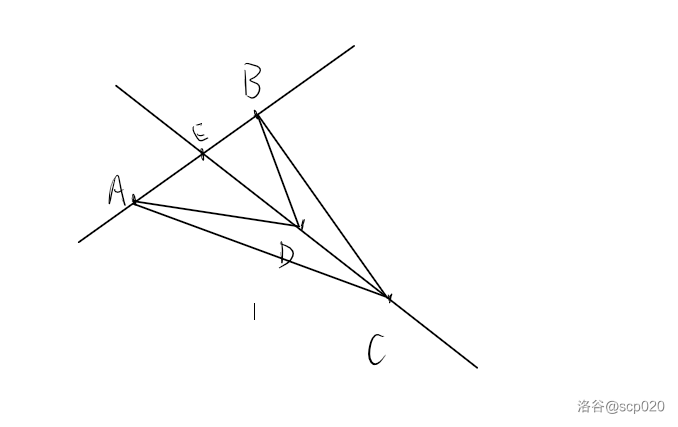UVA378 Intersecting Lines 题解
怎么这么多点斜式邪教啊。
解法
在计算几何中,我们应该尽可能地避免使用浮点数的计算,尽可能地使用向量计算。
本篇题解默认读者具有向量基础。
为了方便讲解,我们将输入的四个点分别记作 A , B , C , D A,B,C,D A,B,C,D。
考虑两条直线 A B , C D AB,CD AB,CD 何时平行。根据向量叉乘的几何意义,如果 A B → × C D → = 0 \overrightarrow{AB} \times \overrightarrow{CD}=0 AB×CD=0,则两直线平行。
直线重合是在直线平行的基础上,如果 C , D C,D C,D 中任一点在直线 A B AB AB 上,则两直线平行。即 A B → × A C → = 0 \overrightarrow{AB} \times \overrightarrow{AC}=0 AB×AC=0(这里取点 C C C)。
剩下的情况就是直线相交了。如图,设两直线交点为 E E E。

根据小学四年级(雾)学的燕尾模型, A E E B = S Δ A D C S Δ B D C \dfrac{AE}{EB}=\dfrac{S_{\Delta ADC}}{S_{\Delta BDC}} EBAE=SΔBDCSΔADC,所以 A E A B = S Δ A D C S Δ A D C + S Δ B D C \dfrac{AE}{AB}=\dfrac{S_{\Delta ADC}}{S_{\Delta ADC}+S_{\Delta BDC}} ABAE=SΔADC+SΔBDCSΔADC,三角形面积可以用叉积轻松求出。
所以两直线交点为 ( X A + ( X B − X A ) × A E A B , Y A + ( Y B − Y A ) × A E A B ) (X_A+(X_B-X_A) \times \dfrac{AE}{AB},Y_A+(Y_B-Y_A) \times \dfrac{AE}{AB}) (XA+(XB−XA)×ABAE,YA+(YB−YA)×ABAE)。
最后提一句,这道题是早期 UVA 题,没有自动忽略文末换行,这题需要有文末换行。
代码
#include<bits/stdc++.h>
namespace fast_IO
{/*** 省略了一部分*/inline void read(int &x,char c=Getchar()){bool f=c!=45;x=0;while(c<48 or c>57) c=Getchar(),f&=c!=45;while(c>=48 and c<=57) x=(x<<3)+(x<<1)+(c^48),c=Getchar();x=f?x:-x;}inline void write(int x){if(x<0) Putchar(45),x=-x;if(x>=10) write(x/10),x%=10;Putchar(x^48);}inline void read(__int128 &x,char c=Getchar()){bool f=c!=45;x=0;while(c<48 or c>57) c=Getchar(),f&=c!=45;while(c>=48 and c<=57) x=(x<<3)+(x<<1)+(c^48),c=Getchar();x=f?x:-x;}inline void write(__int128 x){if(x<0) Putchar(45),x=-x;if(x>=10) write(x/10),x%=10;Putchar(x^48);}inline bool inrange(const char &ch){if(ch>=33 && ch<=126) return true;return false;}inline void read(std::string &st,char c=Getchar()){st.clear();while(!inrange(c)) c=Getchar();while(inrange(c)) st+=c,c=Getchar();}inline void write(std::string st){for(int i=0;i<st.size();i++) Putchar(st[i]);}inline void read(char &ch){ch=Getchar();while(!inrange(ch)) ch=Getchar();}inline void write(const char &ch){Putchar(ch);}inline void write(double x,int fix=2){x+=x>0?my_round[fix+1]:-my_round[fix+1],write((__int128)x),x=x>0?x:-x,x-=(__int128)x;if(fix){Putchar(46);while(fix--) x*=10,Putchar(((int)x)^48),x-=(int)x;}}class fastin{public:template<typename T>inline fastin &operator>>(T &x){read(x);return *this;}};class fastout{public:template<typename T>inline fastout &operator<<(T x){write(x);return *this;}};fastin in;fastout out;
};
using namespace fast_IO;
int n;
struct point
{int x,y;point(){x=y=0;}point(int x,int y){this->x=x,this->y=y;}inline point operator-(const point &rhs) const{return point(x-rhs.x,y-rhs.y);}inline int operator*(const point &rhs){return x*rhs.y-y*rhs.x;}
};
inline int sgn(int x)
{return x==0?0:(x>0?1:-1);
}
struct seg
{point s,t;
};
seg a,b;
inline void calc()
{double ix,iy,rat;rat=(b.t-a.s)*(b.s-a.s)*1.0/((b.t-a.s)*(b.s-a.s)-(b.t-a.t)*(b.s-a.t));ix=a.s.x*1.0+(a.t.x-a.s.x)*rat,iy=a.s.y*1.0+(a.t.y-a.s.y)*rat;out<<"POINT "<<ix<<' '<<iy<<'\n';
}
int main()
{in>>n,out<<"INTERSECTING LINES OUTPUT\n";for(int i=1;i<=n;i++){in>>a.s.x>>a.s.y>>a.t.x>>a.t.y>>b.s.x>>b.s.y>>b.t.x>>b.t.y;if((a.t-a.s)*(b.t-b.s)==0){if((a.t-a.s)*(b.s-a.s)==0) out<<"LINE\n";else out<<"NONE\n";}else calc();}out<<"END OF OUTPUT\n";fwrite(Ouf,1,p3-Ouf,stdout),fflush(stdout);return 0;
}




)

![LeetCode 刷题 [C++] 第3题.无重复字符的最长子串](http://pic.xiahunao.cn/LeetCode 刷题 [C++] 第3题.无重复字符的最长子串)









)

)
